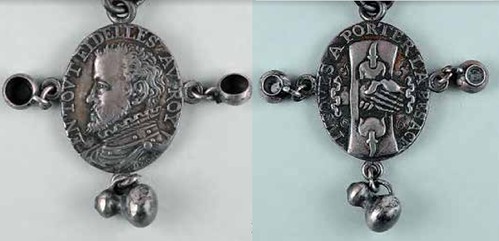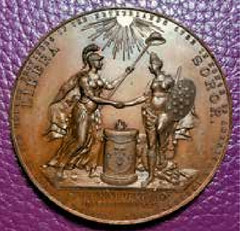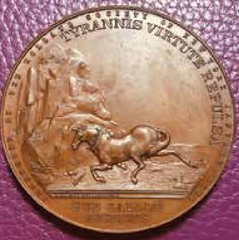
PREV ARTICLE
NEXT ARTICLE
FULL ISSUE
PREV FULL ISSUE
HOLLAND SOCIETY OF NEW YORK SOUVENIRSHarry Waterson published an article in the Summer 2022 issue of de Halve Maen (The Half Moon), the "Magazine of the Dutch Colonial Period in America" published by The Holland Society of New York. With permission, here's an excerpt. -Editor
The men who made
up the Holland Society of New York would have liked it better had it been called the Holland Society of New Amsterdam.
The Holland Society of New York (HSNY) was organized in 1885. On April 30th a constitution was adopted, and the next day
the Society was incorporated in the State of New York. The purpose of the Society was Membership was limited to 1,000 men, all direct descendants through the male line of a Dutchman who was a native or resident of New York or of the American colonies prior to 1675. It was 2016 before women were admitted to full membership in the Society.
On March 30, 1887, a special committee presented a badge design to the trustees. The design was based on ancient geuzenpen-ningen ( Tiffany & Co. prepared the design, and the trustees adopted this form of the Beggars' Badge as the insignia for the Society. The obverse was a left-facing portrait bust of Philip II of Spain surrounded by the motto: EN TOUT FIDELLES AU ROY. The reverse depicts two beggars' wallets, with two hands clasped in the center. Between them is the date 1566 surrounded by the motto JUSQUES A PORTER LABESACE.
The motto is continuous from obverse to
reverse: The story behind this medal is that in 1566, a number of Dutch nobles petitioned Margaret of Parma, King Philip's Regent in the Low Countries, for religious freedom and the end to the Inquisition. They were willing to become beggars to accomplish this including wearing a beggar's wallet around their necks and using begging bowls to live. The nobles wore this medal around their necks. The medal committee thought this Beggars' Medal was the most significant medal ever struck in Holland and considered it a fitting memorial to the first steps toward civil and religious liberty in which the men of the Netherlands led the world. It was considered an appropriate token for a member of the Holland Society to wear in recognition of the benefits he received from the heroic struggles of his Dutch forefathers. The Holland Society had its first annual banquet during the first January of its existence on January 8, 1886. The Society held its 131st annual banquet on October 30, 2021. It has invariably been the highlight of the year for the Society. This article focuses on a run of banquets from 1904 to 1918 when it was the practice to present each member and guest with a souvenir of the evening and, as it turns out, a souvenir of the heritage of the Society. Samuel R. Thayer (1837–1909) was the United States ambassador to the Netherlands from 1889 to 1893. In 1891 he visited the Royal Museum at The Hague. He discovered three medals there from the Dutch Province of Friesland that he considered relevant to prominent events in the history of the United States. Thayer obtained five sets of the medals, copied in zinc at his cost, and donated one set each to the U.S. State Department, the New-York Historical Society, the Massachusetts Historical Society, the Minnesota State Historical Society, and the Holland Society of New York. From October 1891, one set has been preserved among the treasures of the Holland Society. The 19th Annual Banquet of the Holland Society featured replicas of the second medal in the Thayer gift. They were given to all members and guests as souvenirs. The medal was the hit of the evening. It was originally struck to commemorate Holland's recognition of United States Independence.
This medal by Johann Hotzhey is No. 603 in the Betts catalog, in silver size 28 1/2. (1&25/32nds in.) It is assumed the Holland Society zinc example is roughly the same size. The dinner favor is bronze and 44mm, only 1.2mm smaller than the Betts example. In very small lettering there is a continuous legend around both sides: MEDAL STRUCK BY THE UNITED PROVINCES OF THE NETHERLANDS 1782 IN HONOR OF AMERICAN INDEPENDENCE / PRESENTED BY THE HOLLAND SOCIETY OF NEW YORK JANUARY 1904. The medal was struck by Bailey, Banks & Biddle of Philadelphia. Over 400 medals were given out on the night of the dinner. Because of its overwhelmingly good reception, another 400 medals were struck and given to all members who were unable to attend the banquet. All subsequent souvenirs also went to absentees as well. Great history! Thanks to Harry and The Holland Society of New York for sharing this. -Editor
For more information on the Holland Society of New York, see:
Wayne Homren, Editor The Numismatic Bibliomania Society is a non-profit organization promoting numismatic literature. See our web site at coinbooks.org. To submit items for publication in The E-Sylum, write to the Editor at this address: whomren@gmail.com To subscribe go to: https://my.binhost.com/lists/listinfo/esylum All Rights Reserved. NBS Home Page Contact the NBS webmaster 
|



